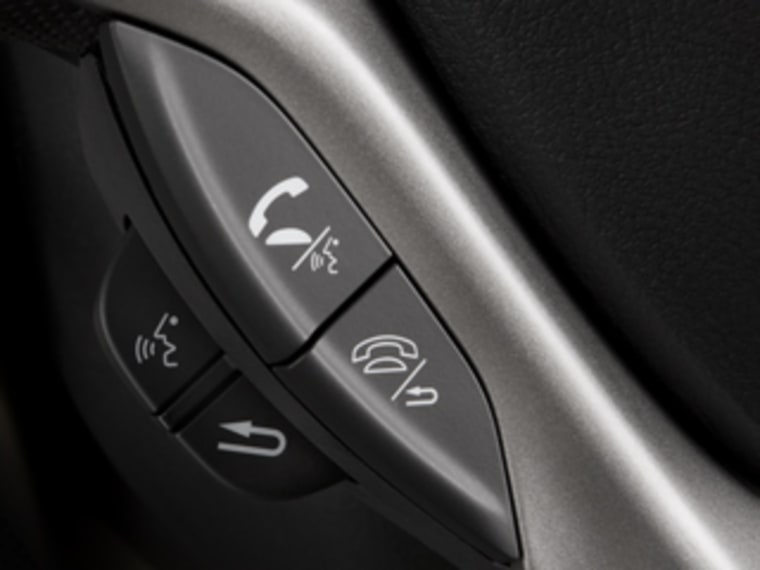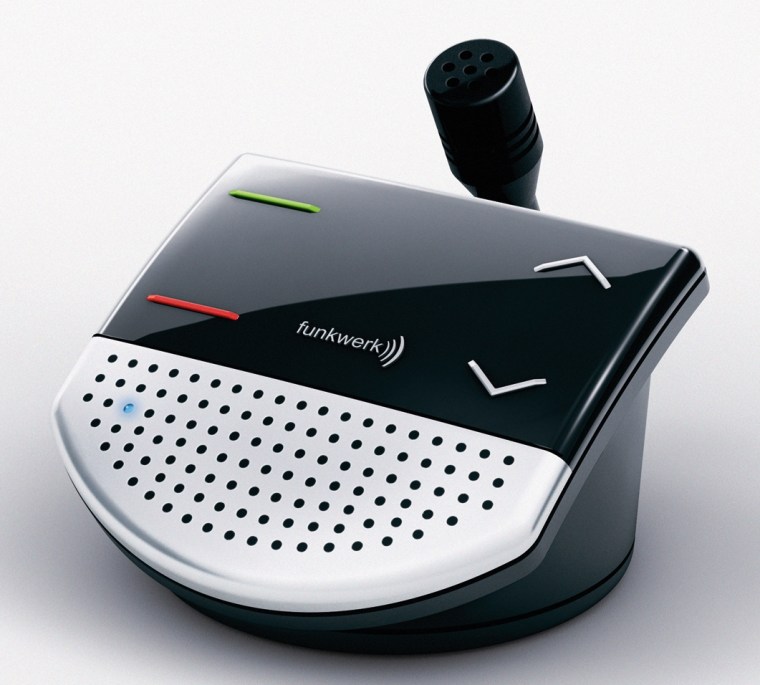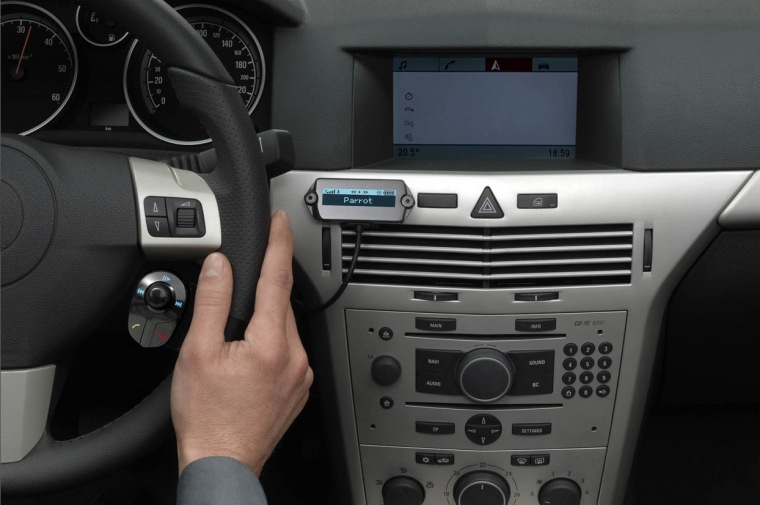Bluetooth doesn’t mean just those odd-looking headsets cell phone users don when they’re walking around city streets. The technology is playing a greater role in automobiles, with more cars having factory-installed Bluetooth for hands-free calls, as well as a growing number of aftermarket devices that do the same thing and transmit digital music files to a car’s stereo system.
The coming years may bring Bluetooth streaming of video to back-seat entertainment units, and perhaps Bluetooth sensors in vehicles that will let drivers know when their tire pressure is too low.
“Next to Bluetooth headsets in the car, the second most popular use of the technology now is being able to use your mobile phone or an MP3 player to stream music through your car stereo using Bluetooth,” said Michael Foley, executive director of the Bluetooth Special Interest Group, which developed the technology.
Four years ago, only some auto manufacturers, such as BMW, Lexus and Chrysler offered Bluetooth in certain models. Now, many carmakers provide it as a factory-installed option, not only for upper-end cars, but in more affordable models such the Nissan Sentra and Ford Focus. Honda recently announced it added Bluetooth to its 2009 Civic EX models equipped with GPS navigation.
Behind the trend is the growing number of laws requiring drivers to keep their hands on the wheel and not on a dial pad. In the United States, several states now require hands-free calling devices for drivers who want to talk on the phone.
California and Washington hands-free laws took effect July 1. New York, New Jersey, Connecticut and Washington, D.C. also have such restrictions. Japan, Britain and France are among other countries that have similar laws.

Bluetooth — named after a 10th-century Danish king — allows devices within a 33-foot range to connect without wires, making the car a good candidate for such devices. In many vehicles, Bluetooth controls are mounted on the steering wheel, or placed on the driver-side visor.
By 2013, nearly 2.4 billion units of Bluetooth-enabled equipment will ship worldwide, with more than half that number representing cell phones, and when headsets are added, it brings the phones and headsets to more than 75 percent of the Bluetooth market, said ABI Research in a recent report.
“A lot of that growth has to do with the new laws that have been passed,” said Douglas McKuen, ABI senior research analyst.
Filomena Berardi of IMS Research, and author of the firm’s report, “The Worldwide Market for Bluetooth in Automotive Applications and the Wireless Car,” estimates the hands-free, new car market this year in the United States will be more than 3 million vehicles. She says that number should double in five years.
Worldwide, by 2013, nearly 30 percent of all new cars will include hands-free features, Berardi said.
Because it can take several years for a new model to be developed, tested and brought to market, “any new feature to be implemented in a new car” takes time, she said. “Take CD players — 20 years on, and they still aren’t standard with every car model.”
Strong Bluetooth aftermarket
It may take time for Bluetooth to be commonplace, but the Bluetooth aftermarket — independent makers of add-on vehicle products — is thriving. In 2007, it was around 25 million units, a 54 percent increase from 2006, said Fiona Thomson, senior market analyst for IMS.
“More people are keeping their cars for five, even 10 years, so there’s a huge, installed base of cars that the aftermarket is looking at,” said Foley of the Bluetooth Special Interest Group.
For consumers who choose the aftermarket route, the cost savings can be substantial. Adding a Bluetooth speaker to the car can cost as little as $50, with higher-end devices between $100 and $300.
With the Sentra, for example, factory-installed Bluetooth is offered as part of a $650 add-on package that includes a remote trunk release, leather-wrapped steering wheel and an integrated overhead CD-holder.
The Focus uses Sync, a hands-free and music streaming technology developed by Ford in collaboration with Microsoft. (Msnbc.com is a joint venture of Microsoft and NBC Universal.) Sync is included as standard equipment on Lincolns and “high-series models from Ford and Mercury,” Ford says, including the Focus SES. As an add-on, it costs $395.
But companies like Parrot, Peiker and Motorola all have Bluetooth car devices that can handle both hands-free calls and stereo-streaming functions and be added to most cars.
“With the Music Series of Parrot car kits, you not only hear the caller’s voice through your car stereo, but you can also stream music wirelessly through your car stereo,” said Mike Hedge of Parrot.
An example of that is the company’s MK6100 Bluetooth Hands-Free Kit, which retails for $300. The controls can be positioned on the steering wheel, and the unit has voice-activated dialing. As with similar products, if you’re using Bluetooth to play music, and a call comes in, the unit automatically mutes the music so you can take the call.
Other devices, like Motorola’s MotoROKR T505 ($139.99 retail), can be clipped to the driver-side visor.
Another product, Funkwerk Americas’ EGO cup ($100 retail), sits in a cup holder and is powered by the cigarette lighter adapter. A microphone juts from the unit, which can be mounted on other surfaces as well.
Combining GPS and Bluetooth
With the continuing popularity of GPS devices, GPS chipmakers such as Texas Instruments, Broadcom and Britain’s CSR, have started adding Bluetooth, as well as FM radio transistors in some cases, to the GPS chips they make.
Some of the newest portable GPS units also have Bluetooth in them to allow hands-free calls. Among them: Garmin’s nuvi 760 ($500), TomTom’s GO 730 ($449.95) and Navigon’s 7200T ($449), due out in October.
GPS chip manufacturers are “starting to integrate Bluetooth and GPS onto the same package, and even onto the same silicon,” mainly because of the cost savings, said McKuen of ABI Research.
“Cellular platforms are very small, and one of the key driving factors of whether or not a technology is used is how much space it takes up,” he said. “If you integrate more functions on the same chip or platform, you’re probably saving the original equipment manufacturer some real estate, and within a device, and that’s a huge plus to them.”
In the pipeline
Bluetooth transmits data at a rate of between 1 and 3 megabits per second, equivalent to Internet broadband speed, and the Bluetooth Special Interest Group is developing an even higher-speed version of Bluetooth.

A faster transmission rate, code named “Seattle,” will make it easier to “bring in video on your mobile phone and stream it to your rear-seat entertainment units,” said Foley of the Bluetooth SIG.
“So, maybe you taped a couple of TV shows the night before, and your kids want to watch them the next day. You can transfer the shows to your phone, then stream them in the car for viewing.”
Foley said the Bluetooth SIG expects to finish work on that specification next year.
Also being worked on is a lower-power version of Bluetooth, due out within the next year or two, that could be used in auto sensors to check tire pressure, engine or oil pressure, he said.
“There’s more integration into the data buses within the car for sensor-type devices that can be wirelessly transmitted into the car for display on the dash and for diagnostics at the shop,” said Foley.
“It may not be real commonly known, but just the wiring in cars these days adds significant amount of weight. So, there’s more interest in being able to use wireless connections to reduce the weight and help with gas efficiency. And Bluetooth is a solution that’s very attractive.”
A Bluetooth tire sensor, for example, would have the same lifetime as the tire itself, so that it is “basically disposable with the tire,” he said.
Berardi, of IMS Research, said such Bluetooth uses could start showing up in cars by 2013.
Despite Bluetooth’s funny-sounding name, more people are learning what it does and what it can means for cars, Foley said.
A year or so ago, he said, only a few people would come up to him and talk to him about using Bluetooth in their vehicles.
“Now, pretty much anyone I meet, when they I hear I work with Bluetooth, brings it up, how it works in their cars, and how they like it. I think in the last year, awareness of hands-free in the car, Bluetooth in the car in general, has really skyrocketed.”
